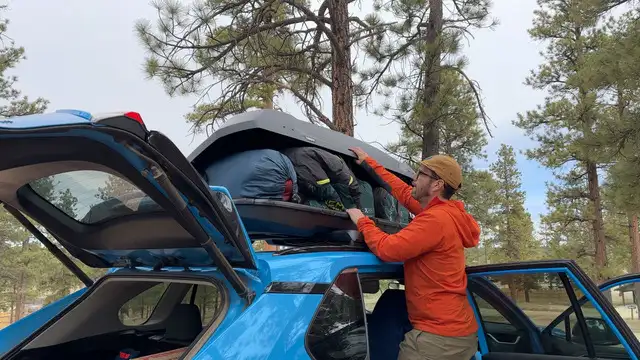
Rooftop cargo boxes are a classic roadtrip staple. Whether you have tons of camping gear and not enough space in the car or simply want to free up interior space for your cooler and snacks, they make carting extra gear easy and efficient. But choosing one from the tons of options out there can seem complicated, especially if you need crossbars, too. But this guide will help you figure out how to choose a vehicle rooftop storage box and which one is right for you.
Rooftop Cargo Boxes and Fuel Efficiency
One of the first questions I had about putting a cargo box on the roof of my car had to do with fuel efficiency. I wanted to know: would gas mileage be worse with a cargo box? If so, how much? After all, I drive a hybrid for both environmental and fuel cost-saving reasons.
The answer: An average sized cargo box affected our MPGs minimally. In fact, during a 10-day road trip to visit all 5 Utah national parks, we got about 4 fewer MPGs on average than without the cargo box. We typically get about 42 MPG and saw an average of 38 with the box. Now, your mileage may vary (literally) depending on the type of car you drive and whether you’ll mostly be on highways. After all, the faster you’re driving (many cargo boxes recommend you not exceed 80 MPH when driving with one attached), the more wind resistance a cargo box will create and therefore result in poorer MPGs.
And obviously as a percentage of fuel efficiency loss, we’re sitting pretty because our hybrid already gets excellent gas mileage. But if you drive a big SUV that gets closer to 20 MPG, 4 fewer is going to feel like a bigger hit. It’s all relative, so keep that in mind if fuel efficiency is a concern.
Pro tip from Ariana Stover, PR & Communications Manager at Thule, though: “If you’re driving an EV or fuel efficiency is your priority, you might opt for a hitch-mounted cargo option.”
Looking for a hitch-mounted cargo box for your car? Check out our review of the Yakima EXO system hitch-mounted and stackable cargo boxes and bike racks.
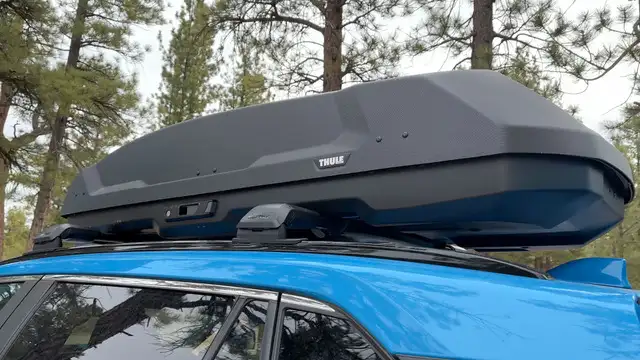
What Size Rooftop Storage Box Should I Get?
“Choosing the right rooftop cargo box starts with how you plan to use it, whether it’s hauling skis, camping gear, or just creating a little more space for everyday life,” Stover says. So what type and size cargo box you should get for your vehicle depends on a few factors:
- The size of your vehicle
- How much gear you’re trying to transport
- What type of gear you’re transporting
- Whether you need space on your roof for other mounted gear
- Vehicle clearance
The size of your vehicle
The size of your vehicle matters most if you drive a coupe or small sedan as you likely have less room on the top of your car for a full-size hardshell cargo box. Crossovers and SUVs don’t often experience size issues unless you’re looking at a really big cargo box. Still, you should always check the dimensions. When searching for a cargo box, check manufacturer websites, most of which have a search filter that allow you to see what options work best with your vehicle, how much weight it can support, whether it may interfere with your trunk, etc. If you have a hatchback, male sure you’ll be able to fully open it with the box attached.
How much gear you’re trying to transport
Obviously how much gear you’re trying to transport will also help determine what type and size of box you need. “Cargo Boxes range in size from about 12 cu ft to around 22 cu ft,” says Evan Hampton, Senior Category Manager at Yakima. If you’re a family of four who goes camping a lot or who has a lot of maximalist packers, chances are you need a larger box than a couple who prefers a minimalist setup. Get a large enough box to fit your needs so you’re not throwing little Gemma on top to weigh the lid down just so you can get it closed. For reference, a 16-cubic foot box was just large enough for two tents and four extra bulky sleep setups on a recent roadtrip.
What type of gear you’re transporting
While quantity is an important metric to consider, so is what you’re actually packing. While most boxes can handle duffels, luggage, and general camping gear, not all are as well suited for items like snowboards, skis, or large, bulky gear. “Do you need to transport skis? You will want to focus on a Cargo Box that is long enough if the answer is yes,” Hampton says. So check the length of the boxes you’re considering to make sure the stuff you transport most often will fit (and that it’s easy to secure inside). Don’t forget to find out what the weight rating is, too, if you plan on hauling extra heavy items.
Whether you need space on your roof for other mounted gear
If you travel with lots of gear like we often do (camping equipment, mountain bike gear, clothing, etc.), you may only have part of your roof to dedicate to a rooftop storage box. Like if you also use your roof rack and crossbars to mount your bike or transport a kayak. If that’s the case, look for a narrow box that leaves enough space for your other toys.
Keep clearance in mind
Don’t forget to consider the height of your cargo box and crossbars. Especially if you plan to keep the box on for a season or longer (like if you use it to transport skis a few times a week). If you still want to be able to park your car in your garage and go through drive-thrus and into parking garages, take into consideration how much taller it will make your vehicle. Don’t get one that’s too tall or just under the line or you’ll regret it every time you want to order a burrito without getting out of your car.
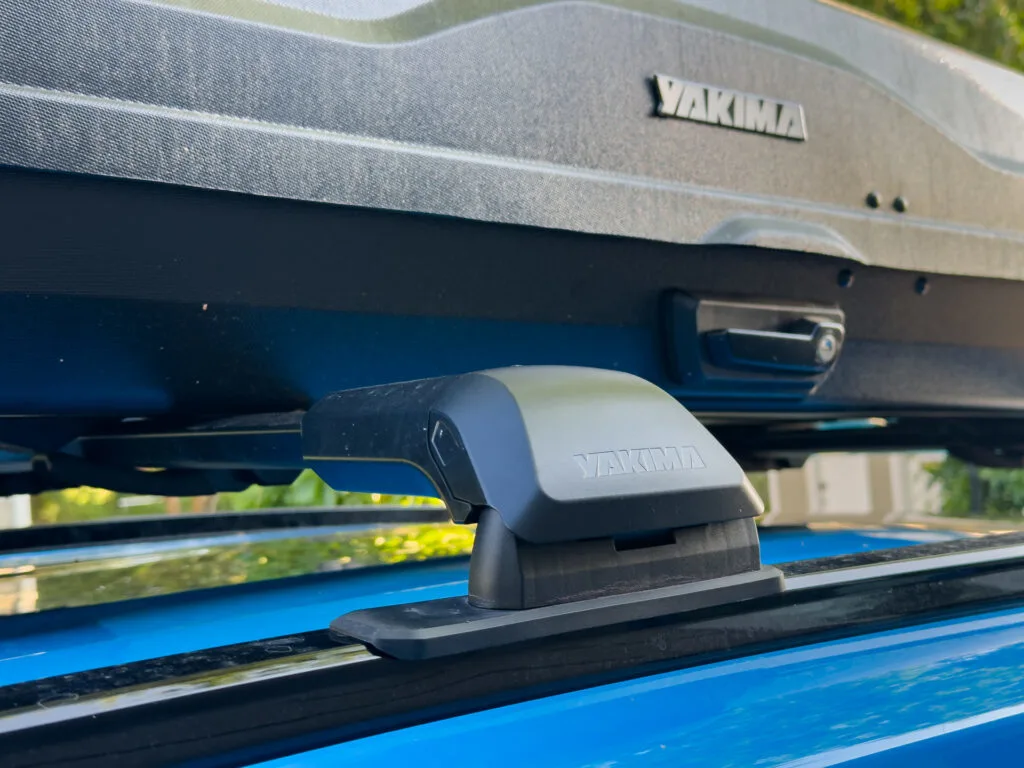
Rails, Crossbars and Towers!
Crossbars are what a cargo box will sit on top of on your roof. They’re the bars that run perpendicular to the length of your car, usually attached to rails or towers. Most vehicles don’t come fresh off the lot with crossbars that are ready to mount a rooftop cargo box to. Which means you’ll likely need to purchase an after-market set (they typically come in a pair). What type and size you need depends entirely on your car. There are a few universal options out there, but a model specifically suited to your vehicle will typically fit better, be easier to use, and be less finicky. We required the SkyLine FX System Towers and bars in conjunction with the Streamline System Landing Pads for our Toyota Rav4.
They often fit securely onto your vehicle’s specific roof rails (the raised rails that run down the sides of your roof). If you don’t have roof rails (called a naked roof), like if you drive a sedan or smaller crossover, there are crossbar options available with feet or towers that clamp directly onto your roof instead.
Make sure to read descriptions carefully either way, because some systems come with everything you need while others require you to buy towers separately from crossbars.
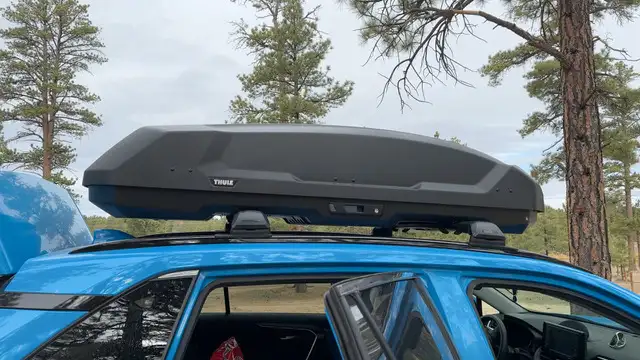
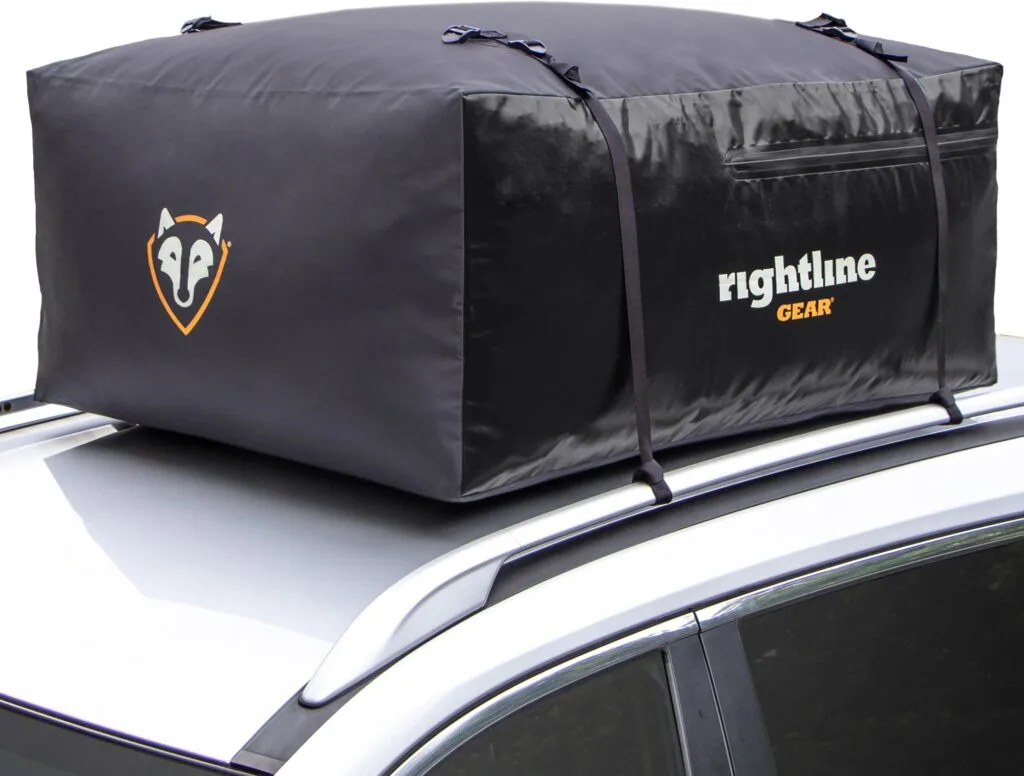
Soft-Sided vs Hard-Sided Cargo Boxes
You have two main options when it comes to rooftop cargo boxes: soft-sided and hard-sided. There are pros and cons to each. We prefer a hard-sided box, personally, but soft-sided rooftop storage bags are hugely popular lately. Here’s a pros and cons list to help you decide which is right for you.
Hard-Sided Pros and Cons
Pros:
- Sturdy and ultra durable
- Ultra protective
- Waterproof
- Can store hard, soft, bulky or small items safely
- They don’t have to be even close to completely full
- Often streamlined for fuel efficiency
- More theft-proof
- Long-lasting
- Can personalize with stickers! (We think this is a pro…)
Cons:
- Expensive
- Heavy
- Take up a lot of space when removed and not in use
Soft-Sided Pros and Cons
Pros:
- Less expensive
- Easier to mount
- Often universal fit so less complicated to find the right fit
- Lighter weight
- Take up little space when removed and not in use
Cons:
- Not usually as fuel efficient
- Have to be packed full or mostly full
- Not as durable
- Can be more susceptible to weather
- Not theft-resistant
- Can’t transport hard-sided items or longer gear like snowboards
Our Favorite Rooftop Cargo Boxes
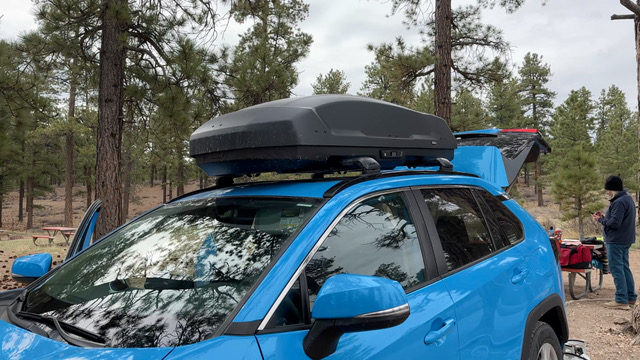
Thule Force 3
Size
16 cubic feet
43 lbs.
76.8 x 33.3 x 16.8 in
This spacious box fit all the sleeping and camping gear for four people on a recent 10-day road trip. And we did not pack light. There were two 3-person tents, four chairs, two self-inflating foam sleeping mattresses and two double sleeping bags, and a campground game or two.
Did we have to really smash some of those bulky, compressive items in when it came time to close and latch the box? Sure. But when it comes down to it, it all fit. We commented several times on how much stuff this box can hold.
And yes, it’s also long enough for 5-7 pairs of skis and 3-5 snowboards (up to 175 cm).
Features
- PowerClick mounting: The mounting system with turn dial indicates when the cargo box is securely attached with a nice loud click.
- DualSide accessibility: The box provides easy access to contents from either side of the vehicle so no matter how you park your car your stuff is accessible.
- Secure lid lock: The SlideLock system has separate locking and opening functions and automatically locks the lid in place then indicates when the box is closed securely.
- Access to the trunk: Full trunk access is basically guaranteed thanks to the box’s forward position on the vehicle roof.
- Webbing on the inside: if you want or need to secure your stuff inside the box, webbing offers the option to lash it in place.
Functionality
Easy to mount, easy to use, easy to lock. There’s little we didn’t like about this cargo box. Being able to get into it from either side meant we didn’t have to worry about how we were parked or which side the campsite was on. The installation felt simple and secure and when driving wind noise was minimal even at highway speeds.
Interior space was abundant and there was enough room to store bulky camping gear for four people.
•
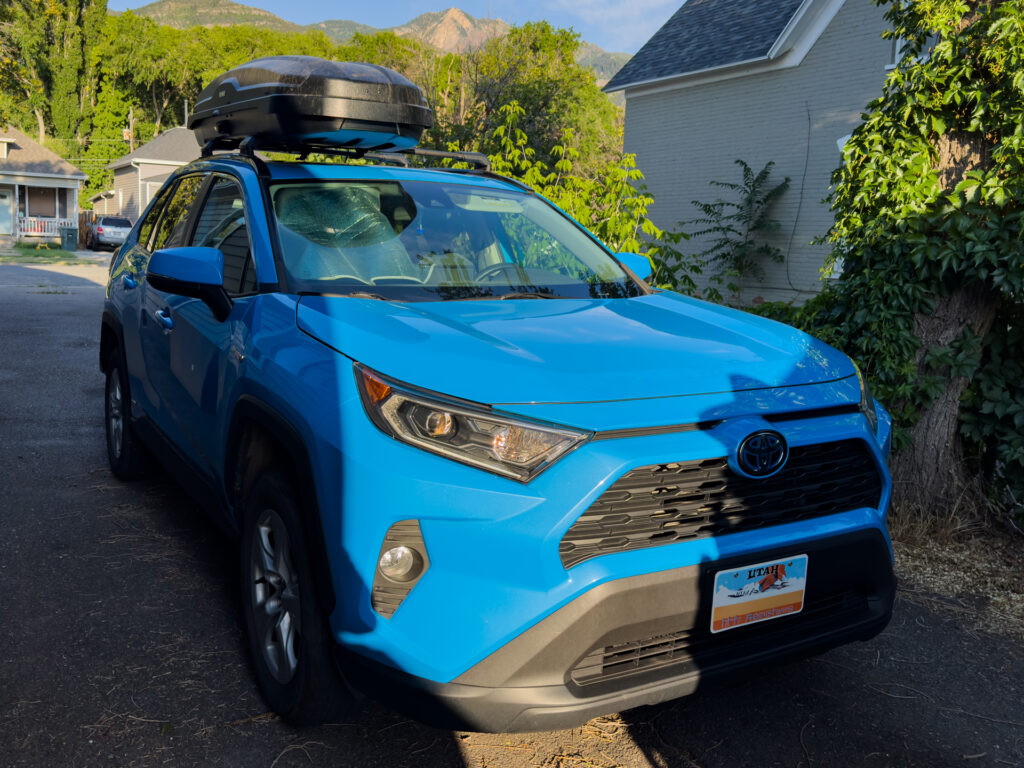
Yakima SkyBox NX Skinny
Size
12 cubic feet
43 lbs.
L 84 in x W 26.5 in x H 16 in
This particular Yakima roof box is smaller, but the brand offers lots of other sizes in this style, so if roof box capacity is more important than leaving extra room on your roof for other gear, size up. This one is slightly longer, but quite a bit narrower than the Thule (as well as other roof boxes), and that’s on purpose: it’s designed to free up some roof space for other toys, say a kayak or bike.
And honestly, it didn’t feel that much smaller than the Thule. It’s also the same weight, which says to me it uses more robust components.
It’ll hold gear for up to 3 campers (we fit a bulky sleep setup, tent, and chairs for two inside with plenty of room leftover) or 2 snowboards or 3 pairs of skis (up to 195 cm).
Features
- Lockable handles: A full metal opening handle with locking mechanism is easy to use and locks gear inside the box and the box to the vehicle.
- Removable torque-limiting knob: Put it on during install, turn until you hear the loud click, and know you’ve achieved a safe and secure installation
- More usable internal space: An unobstructed, flattened floor provides more space for gear so the box feels bigger than some similarly sized roof boxes.
- Hatch clearance: Even with a slightly longer length it’s easy to achieve hatch clearance.
- Dual-sided opening: It opens on either side of your vehicle for easy access to all your gear no matter what.
- Interior tie-down points: If you want to lash loose gear, built-in tie-downs make it possible.
Functionality
The Yakima SkyBox looked more svelte on top of our vehicle thanks to its slimmer size and shape. That didn’t seem to affect fuel efficiency much compared to a larger box (we still say a drop of about 4 MPG on average). There was still plenty of space for camping gear for two to four people: we fit a giant two-person bag and sleeping pad plus tent inside with plenty of room to spare. Plus it was easy to mount, lock, and felt secure on the roof and made a tolerable amount of noise when driving at highway speeds. It also resulted in slightly better MPGs on average.
Since it’s skinnier, placing it in the middle of the car meant we had to reach a few more inches than with wider boxes, but we didn’t mind. Especially since it offers the option to mount other gear next to it. That said, if you do mount it on the side of your vehicle so you can add gear to the other side, the dual-side opening functionality will be a wash.
Bottom Line: Choosing a Rooftop Cargo Box
What type, brand and size of rooftop cargo box is right for you depends on you, your needs, how you travel, and what you travel with. So when shopping for one, make sure to take all that into consideration, plus double check gear setup requirements, clearance, and measurements of your vehicle and you’ll end up with a rooftop storage box that’s perfect for you and every roadtrip for years to come. Wander on.
